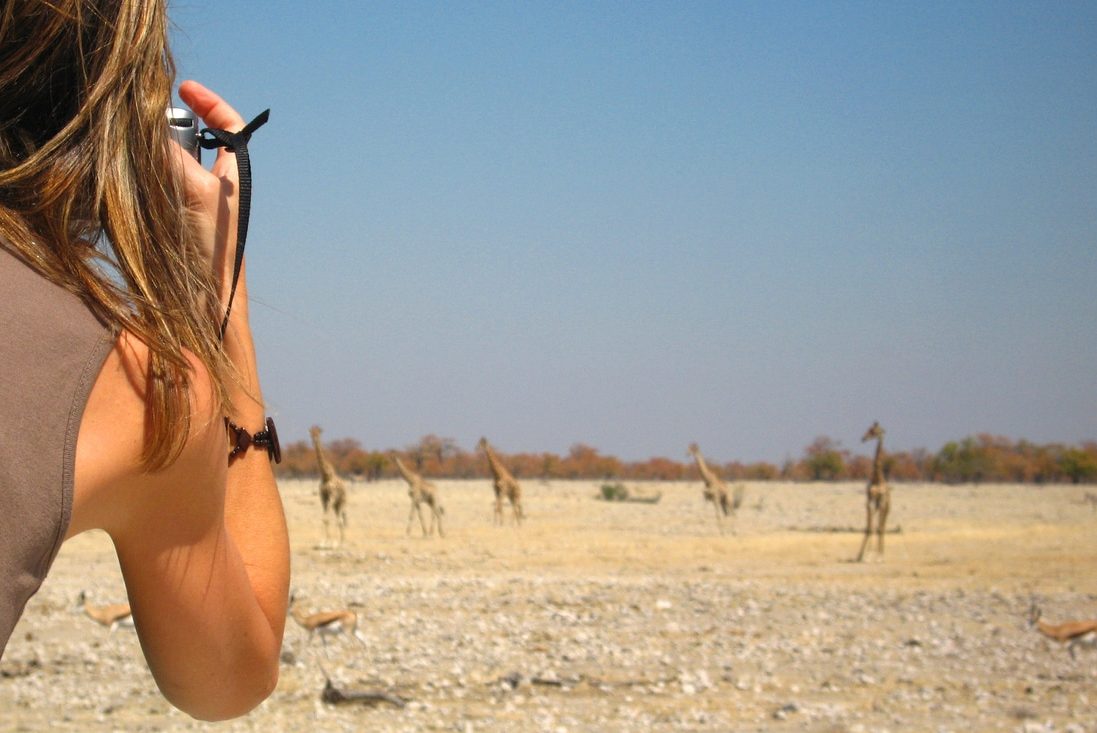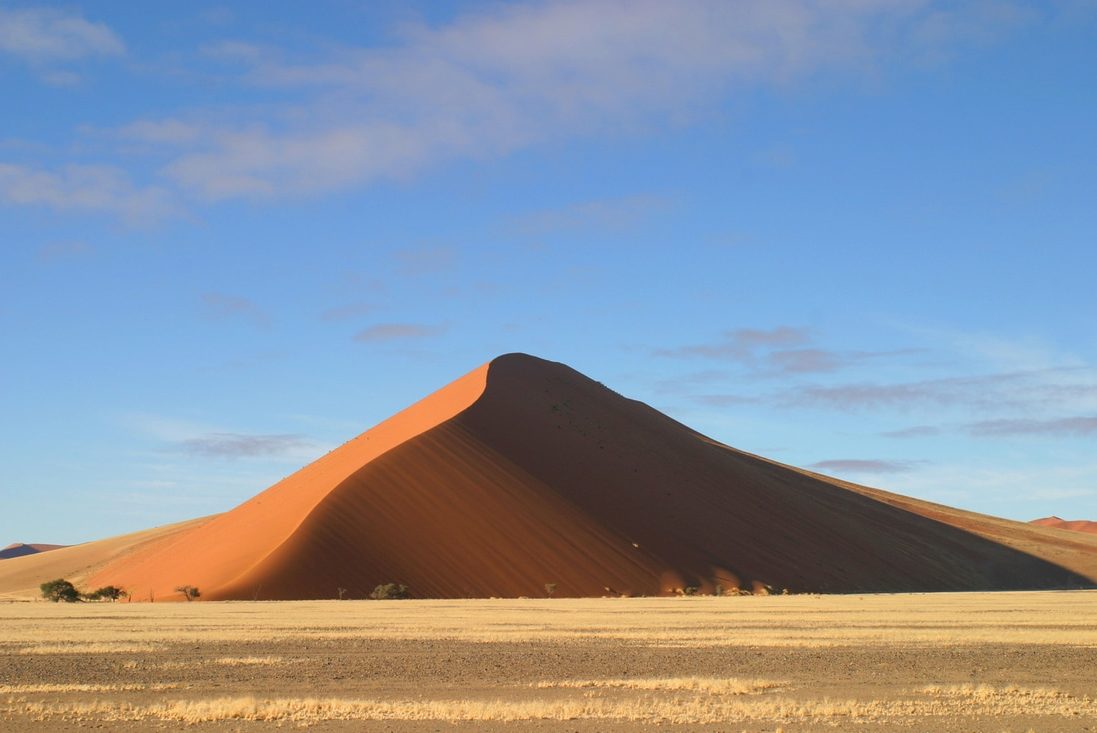Namibia & Botswana
17 nights
1 nights Windhoek – Namibia
1 nights Soussusvlei – Namibia
2 night Swakopmund & Walvis Bay – Namibia
2 nights Damaraland – Namibia
2 nights Koakoveld – Puros – Namibia
1 night Koakoveld – Orupembe – Namibia
2 nights Cunene, Epopa Falls and Himba – Namibia
3 nights Etosha – Namibia
1 night Rundu – Namibia
2 nights Okavango Pan Handle – Botswana
Lodge based safari
Minimum 4 Pax for the safari to run
Maximum 8 Pax
SAFARI GUIDE: Disho
Extensions to Moremi and Victoria Falls available
Namibia is a vast country, even by African standards, covering an area approximately four times the size of the United Kingdom but with a population of a mere 2 million – one of the lowest densities in the world. It is also an ‘ageless land’; visible through our heritage of rock art created by stone-age artists and geological attractions such as the petrified forest where fossilised tree trunks have lain for over 280 million years. Added to the space and silence, these all contribute to a feeling of antiquity, solitude and wilderness. The climate is typical of a semi-desert country. Days are warm to hot and nights are generally cool. Temperatures are modified by the high plateau in the interior and by the cold Benguela Current that runs along the Atlantic coastline. Except for the first few months of the year, the country is generally dry with very little rain.
Some of the highlights include:
Windhoek, Namibia’s capital nestles among rolling hills, bounded by the Eros Mountains in the east, the Auas Mountains to the south and the Khomas Hochland in the west. It is a meeting place between Africa and Europe, the modern and the old. In the capital’s main street, well-preserved German colonial buildings are in sharp contrast with modern architectural styles, while Herero women in their traditional Victorian dresses mingle with executives dressed in the latest fashions. Located centrally, Windhoek is the starting point of an adventures holiday for many visitors to the country and an ideal base from where to explore the rest of the country. The city’s restaurants offer a variety of meals, ranging from international and continental cuisine to German dishes such as Eisbein with Sauerkraut and African delicacies such as Mopane worms. Windhoek offers a wide choice of accommodation options, ranging from four-star hotels and homely pensions to backpackers establishments and campsites. In the rural areas beyond the city’s limits there are also a number of lodges and guest farms.
Sossusvlei: This most frequently visited section of the massive 50,000 km² Namib Naukluft National Park has become known as Sossusvlei, famous for its towering apricot coloured sand dunes which can be reached by following the Tsauchab River valley. Sossusvlei itself is actually a clay pan set amidst these star shaped dunes which stand up to 300 meters above the surrounding plains, ranking them among the tallest dunes on earth. The deathly white clay pan contrasts against the orange sands and forms the endpoint of the ephemeral Tsauchab River, within the interior of the Great Sand Sea. The river course rises south of the Naukluft Mountains in the Great Escarpment. It penetrates the sand sea for some 55 km before it finally peters out at Sossusvlei, about the same distance from the Atlantic Ocean. Until the encroaching dunes blocked its course around 60,000 years ago, the Tsauchab River once reached the sea; as ephemeral rivers still do in the northern half of the Namib. Sand-locked pans to the west show where the river previously flowed to before dunes shifted its endpoint to where it currently gathers at Sossusvlei. Roughly once a decade rainfall over the catchment area is sufficient to bring the river down in flood and fill the pan. On such occasions the mirror images of dunes and camel thorn trees around the pan are reflected in the water. Sossusvlei is the biggest of four pans in the vicinity. Another, famous for its gnarled and ghostly camel thorn trees, is Deadvlei which can be reached on foot over 1 km of sand. Deadvlei’s striking camel thorn trees, dead for want of water, still stand erect as they once grew. They survived until about 900 years ago when the sand sea finally blocked the river from occasionally flooding the pan.
Etosha National Park: Etosha National Park covers 22,270 km², of which approximately 5,000 km² is made up of saline depressions or ‘pans’. The largest of these pans, the Etosha Pan, can be classified as a saline desert in its own right. The Etosha Pan lies in the Owambo Basin, on the north-western edge of the Namibian Kalahari Desert. Until three million years ago it formed part of a huge, shallow lake that was reduced to a complex of salt pans when the major river that fed it, the Kunene, changed course and began to flow to the Atlantic instead. If the lake existed today, it would be the third largest in the world. Etosha is the largest of the pans at 4,760 km² in extent. It is nowadays filled with water only when sufficient rain falls to the north in Angola, inducing floods to flow southward along the Cuvelai drainage system.
The Himba: The Himba, Tjimba and other Herero people who inhabit Namibia’s remote north-western Kunene Region are loosely referred to as the Kaokovelders. Basically Herero in terms of origin, language and culture, they are semi-nomadic pastoralists who tend to tend from one watering place to another. They seldom leave their home areas and maintain, even in their own, on which other cultures have made little impression. For many centuries they have lived a relatively isolated existence and were not involved to any noteworthy extent in the long struggle for pasturelands between the Nama and the Herero. The largest group of Kaokovelders is the Himba, semi-nomads who live in scattered settlements throughout the Kunene Region. They are a tall, slender and statuesque people, characterized especially by their proud yet friendly bearing. The women especially are noted for their unusual sculptural beauty, enhanced by intricate hairstyles and traditional adornments. They rub their bodies with red ochre and fat, a treatment that protects their skins against the harsh desert climate. The homes of the Himba of Kaokoland are simple, cone-shaped structures of saplings, bound together with palm leaves and plastered with mud and dung. The men build the structures, while the women mix the clay and do the plastering. A fire burns in the headman’s hut day and night, to keep away insects and provide light and heating. A family may move from one home to another several times a year to seek grazing for their goats and cattle. Men, women and children wear body adornments made from iron and shell beads. A Himba woman spends as much as three hours a day on her toilette. First she bathes, then she anoints herself with her own individually prepared mixture which not only protects her skin from the harsh desert sun, but also keeps insects away and prevents her body hair from falling out. She uses another mixture of butter fat, fresh herbs and black coals to rub on her hair, and ‘steams’ her clothes regularly over the permanent fire. Men, women and children adorn themselves with necklaces, bracelets, anklets and belts made from iron and shell beads. With their unusual and striking designs, these items have gained a commercial value and are being produced on a small scale for the urban market. Sculptural headrests in particular are sought-after items.
Each specialist photographic safari is conducted around light and behavior and includes wildlife photography tuition and post editing by our photographer Guide.
What includes:
- Luxury and comfortable rooms in the selected Lodges.
- Services of a professional guide, safari chef and camp assistants.
- Game drives and local transfers in customized safari vehicles (Toyota Land Cruiser 4×4).
- All entrance and camping fees within the national parks and reserves.
- All meals and drinks (Water, soft drinks, beer, wine…) for the duration of the safari.
- All activities as specified in the itinerary.
What excludes:
- International flights.
- Visas if necessary.
- All drinks in the lodges.
- Personal assistance and cancellation insurance.
- Staff gratuities.
- Safari extensions.
Get in touch to find out more!





